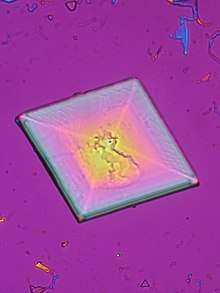Niter
Niter, or nitre (chiefly British[4]), is the mineral form of potassium nitrate, KNO3, also known as saltpeter or saltpetre. Historically, the term niter was not well differentiated from natron, both of which have been very vaguely defined but generally refer to compounds of sodium or potassium joined with carbonate or nitrate ions.
| Niter | |
|---|---|
 A niter crystal under a polarizing microscope | |
| General | |
| Category | Nitrates, oxide mineral |
| Formula (repeating unit) | KNO3 |
| Strunz classification | 5.NA.10 |
| Dana classification | 18.1.2.1 |
| Crystal system | Orthorhombic |
| Crystal class | Dipyramidal (mmm) H-M symbol: (2/m 2/m 2/m) |
| Space group | Cmc21 |
| Identification | |
| Color | white |
| Crystal habit | druse or acicular |
| Cleavage | very good on {001}; good on {010} |
| Fracture | brittle |
| Mohs scale hardness | 2 |
| Luster | vitreous |
| Streak | white |
| Diaphaneity | transparent |
| Specific gravity | 2.10 (calc.) |
| Refractive index | nα = 1.332 nβ = 1.504 nγ = 1.504 |
| Solubility | soluble |
| References | [1][2][3] |
Related minerals are soda niter (sodium nitrate), ammonia niter or gwihabaite (ammonium nitrate), nitrostrontianite (strontium nitrate), nitrocalcite (calcium nitrate), nitromagnesite (magnesium nitrate), nitrobarite (barium nitrate) and two copper nitrates, gerhardtite and buttgenbachite; in fact all of the natural elements in the first three columns of the periodic table and numerous other cations form nitrates which are uncommonly found for the reasons given, but have been described. Niter was used to refer specifically to nitrated salts known as various types of saltpeter (only nitrated salts were good for making gunpowder) by the time niter and its derivative nitric acid were first used to name the element nitrogen, in 1790.
Because of its ready solubility in water, niter is most often found in arid environments and often in conjunction with other soluble minerals like halides, iodates, borates, gypsum, and rarer carbonates and sulphates. A major source of sodium nitrate mineral ("Chile saltpeter" or nitratine) is the Atacama Desert in Chile. Potassium and other nitrates are of great importance for use in fertilizers and, historically, gunpowder. Much of the world's demand is now met by synthetically produced nitrates, though the natural mineral is still mined and is still of significant commercial value.
Description
Niter is a colorless to white mineral crystallizing in the orthorhombic crystal system. It usually is found as massive encrustations and efflorescent growths on cavern walls and ceilings where solutions containing alkali potassium and nitrate seep into the openings. It occasionally occurs as prismatic acicular crystal groups, and individual crystals commonly show twinning. Niter and other nitrates can also form in association with deposits of guano and similar organic materials.
History
Niter as a term has been known since ancient times, although there is much historical confusion with natron (an impure sodium carbonate/bicarbonate), and not all of the ancient salts known by this name or similar names in the ancient world contained nitrate. The name is from the Ancient Greek νιτρων nitron from Ancient Egyptian netjeri, related to the Hebrew néter, for salt-derived ashes (their interrelationship is not clear).
The Hebrew néter may have been used as, or in conjunction with soap, as implied by Jeremiah 2:22, "For though thou wash thee with niter, and take thee much soap..." However, it is not certain which substance (or substances) the Biblical "neter" refers to, with some suggesting sodium carbonate. Indeed, the Neo Latin word for sodium, natrium, is derived from this same class of desert minerals called natron (French) from Spanish natrón through Greek νίτρον (nitron), derived from Ancient Egyptian netjeri, referring to the sodium carbonate salts occurring in the deserts of Egypt, not the nitrated sodium salts typically occurring in the deserts of Chile (classically known as "Chilean saltpeter" and variants of this term).[5]
A term (ἀφρόνιτρον, aphronitron or Aphronitre) which translates as "foam of niter" was a regular purchase in a fourth-century AD series of financial accounts, and since it was expressed as being "for the baths" was probably used as soap.[6]
Niter was used to refer specifically to nitrated salts known as various types of saltpeter (only nitrated salts were good for making gunpowder) by the time niter and its derivative nitric acid were first used to name the element nitrogen, in 1790.
See also
- Nitrary, a place for making Niter
References
- "Niter Mineral Data". www.webmineral.com.
- "Niter: Mineral information, data and localities". www.mindat.org.
- Adiwidjaja, G.; Pohl, D. (2003), "Superstructure of α-phase potassium nitrate", Acta Crystallogr. C, 59 (12): 1139–40, doi:10.1107/S0108270103025277.
- "Definition of nitre". Merriam-Webster. Retrieved 11 March 2016.
- "neter and nitrogen".
- More conventional soap also appears in the accounts but was more expensive: John Matthews, The Journey of Theophanes, Yale UP 2006
External links
| Wikimedia Commons has media related to Niter. |